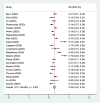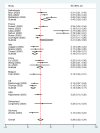Incidence of thromboembolism in patients with COVID-19: a systematic review and meta-analysis
- PMID: 33292258
- PMCID: PMC7680990
- DOI: 10.1186/s12959-020-00248-5
Incidence of thromboembolism in patients with COVID-19: a systematic review and meta-analysis
Erratum in
-
Correction to: Incidence of thromboembolism in patients with COVID-19: a systematic review and meta-analysis.Thromb J. 2020 Dec 29;18(1):39. doi: 10.1186/s12959-020-00254-7. Thromb J. 2020. PMID: 33372614 Free PMC article. No abstract available.
Abstract
Background: Since the beginning of the coronavirus disease 2019 (COVID-19) pandemic, the incidence of thromboembolism has been increasingly reported. The aim of this systematic review was to explore the incidence of venous and arterial thromboembolism among COVID-19 patients requiring hospitalization.
Methods: Medline, Embase, Scopus, and grey literature were searched until June 2020. Observational studies reported on the incidence of venous thromboembolism (VTE), including pulmonary embolism (PE) and deep vein thrombosis (DVT) or arterial thromboembolism (ATE) were included. The pool incidences and their 95% confidence intervals (CI) were calculated using the random-effects model.
Results: A total of 36 studies were included. In the intensive care unit (ICU) setting, the pooled incidence of VTE was 28% (95% CI, 22-34%). Subgroups based on compression ultrasound (CUS) screening revealed a higher incidence of DVT in the CUS screening group than in the no CUS screening group (32% [95% CI, 18-45%] vs. 6% [95% CI, 4-9%]). The pooled incidence of ATE in ICU was 3% (95% CI, 2-5%). In the non-ICU setting, the pooled incidence of VTE was 10% (95% CI, 6-14%,).
Conclusions: The incidence of VTE in COVID-19 patients was higher in the ICU setting than in the non-ICU setting, and also significantly higher in studies that incorporated the CUS screening protocol. The incidence of ATE in the ICU setting was low. VTE prophylactic measures should be given to all hospitalized patients diagnosed with COVID-19.
Keywords: Arterial thromboembolism; COVID-19; Meta-analysis; Venous thromboembolism.
Conflict of interest statement
The authors declare no competing financial interests.
Figures



Similar articles
-
Systematic review and meta-analysis of the prevalence of venous thromboembolic events in novel coronavirus disease-2019 patients.J Vasc Surg Venous Lymphat Disord. 2021 Mar;9(2):289-298.e5. doi: 10.1016/j.jvsv.2020.11.023. Epub 2020 Dec 9. J Vasc Surg Venous Lymphat Disord. 2021. PMID: 33309903 Free PMC article.
-
Venous Thromboembolism in Hospitalized Critical and Noncritical COVID-19 Patients: A Systematic Review and Meta-analysis.TH Open. 2021 Jul 6;5(3):e286-e294. doi: 10.1055/s-0041-1730967. eCollection 2021 Jul. TH Open. 2021. PMID: 34240001 Free PMC article.
-
Venous thromboembolism in patients with COVID-19: Systematic review and meta-analysis.Thromb Res. 2020 Dec;196:67-74. doi: 10.1016/j.thromres.2020.08.020. Epub 2020 Aug 12. Thromb Res. 2020. PMID: 32853978 Free PMC article.
-
Risk of venous thromboembolism in patients with COVID-19: A systematic review and meta-analysis.Res Pract Thromb Haemost. 2020 Oct 13;4(7):1178-1191. doi: 10.1002/rth2.12439. eCollection 2020 Oct. Res Pract Thromb Haemost. 2020. PMID: 33043231 Free PMC article.
-
A systematic review and meta-analysis of incidence, prognosis, and laboratory indicators of venous thromboembolism in hospitalized patients with coronavirus disease 2019.J Vasc Surg Venous Lymphat Disord. 2021 Sep;9(5):1099-1111.e6. doi: 10.1016/j.jvsv.2021.01.012. Epub 2021 Jan 30. J Vasc Surg Venous Lymphat Disord. 2021. PMID: 33529719 Free PMC article.
Cited by
-
COVID-19 Induced Coagulopathy (CIC): Thrombotic Manifestations of Viral Infection.TH Open. 2022 Mar 10;6(1):e70-e79. doi: 10.1055/s-0042-1744185. eCollection 2022 Jan. TH Open. 2022. PMID: 35280973 Free PMC article.
-
Circulating biomarkers of inflammaging as potential predictors of COVID-19 severe outcomes.Mech Ageing Dev. 2022 Jun;204:111667. doi: 10.1016/j.mad.2022.111667. Epub 2022 Mar 25. Mech Ageing Dev. 2022. PMID: 35341896 Free PMC article. Review.
-
Sex- and age specific association of new-onset atrial fibrillation with in-hospital mortality in hospitalised COVID-19 patients.Int J Cardiol Heart Vasc. 2022 Apr;39:100970. doi: 10.1016/j.ijcha.2022.100970. Epub 2022 Feb 4. Int J Cardiol Heart Vasc. 2022. PMID: 35136831 Free PMC article.
-
The COVID Complex: A Review of Platelet Activation and Immune Complexes in COVID-19.Front Immunol. 2022 Mar 14;13:807934. doi: 10.3389/fimmu.2022.807934. eCollection 2022. Front Immunol. 2022. PMID: 35371058 Free PMC article. Review.
-
Non-recommended medical interventions and their possible harm in patients with COVID-19.Ther Adv Infect Dis. 2021 Jul 23;8:20499361211034070. doi: 10.1177/20499361211034070. eCollection 2021 Jan-Dec. Ther Adv Infect Dis. 2021. PMID: 35154700 Free PMC article. No abstract available.
References
LinkOut - more resources
Full Text Sources
Other Literature Sources
Medical
Research Materials

